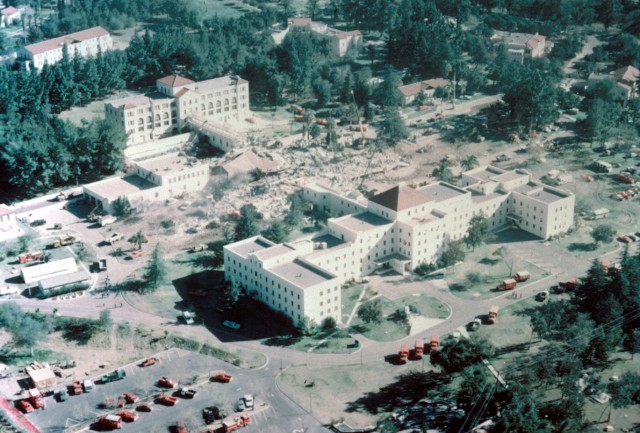Let's take those two parts separately: first, structural integrity. Second, what the state calls "non-structural performance," or ability to operate.
Under the Seismic Safety Act every hospital building in the state has been assessed for structural integrity and rated 1-5 ("1" being at-risk of complete collapse in an earthquake).
You can look up the assessment of every building in every hospital statewide. (The spreadsheet is highly detailed, so give yourself some time.)
The greatest concern was around buildings deemed most at risk of collapse, those rated SPC 1.
Yes, it's been 20 years since the law was passed, and there have been rounds of delays, a wait for regulations, a significant recession and more, but today, 88 percent of the state's hospital acute care buildings with an SPC 1 rating have been upgraded, according to the Office of Statewide Health Planning and Development. OSHPD is responsible for overseeing compliance. They no longer are deemed at risk of collapse.
"Some of (the hospitals) had to do minor retrofitting; others had to do a complete rebuild," said Jan Emerson-Shea, spokesperson with the California Hospital Association.
Of the SPC 1 buildings still not in compliance, some are looking at a Jan. 1, 2015 deadline, while a few more have until 2020. (SPC 2 buildings must be compliant by 2030; SPC 3-5 are considered seismically sound.)
At A Cost of Billions
Emerson-Shea stressed that the California Hospital Association "always supported the public policy goal" of seismically safe hospitals, but this has been an extraordinarily expensive law.
"It's the most expensive unfunded mandate in the history of the state of California," she said. While county-owned or district-owned hospitals can seek additional money from local taxpayers, she said, "for the majority of privately owned hospitals, there is no source of funding other than the hospital itself."
Then there's the other deadline. By 2030, all acute care hospital buildings must be engineered to be fully operational after an earthquake. For many hospitals, the path of least resistance to meet both standards appeared to be rebuilding.
Kaiser Permanente has been on a statewide hospital building boom for several years. Since 2007, Kaiser has built 11 hospitals to replace buildings that did not meet the state standards. A 12th is scheduled to open in December.
All this at a cost of roughly $7 billion.
"There was an expense, but it was a commitment we made," said Scott Bell, Kaiser's executive director of facilities, planning and design. He said all the hospitals are designed to meet a standard referred to as a "475 year event," an earthquake along the lines of the 1906 earthquake in San Francisco.
In addition to the seismic integrity of the building itself, the regulations "require that we brace all our systems," he said. "Even sprinkling piping has to be braced. ... If it's movable equipment, we tether it to the wall, if it's stationary, we bolt it to the ground. We have specific requirements that all the pieces are anchored."
"I have a lot of confidence in our facilities being able to survive a major event," Bell said, and added that the new hospitals are all rated SPC 5, the highest level of seismic safety.
Jan. 1, 2015 Deadline
While 88 percent of the state's SPC 1 buildings are already compliant, five hospitals statewide are staring down a Jan. 1, 2015 deadline. Each hospital has at least one patient-care building assessed at SPC 1 and is close to completing a new facility.
But the law states that if the replacement building is not ready, the current seismically unsafe patient-care building must be shut down. There's no flexibility in the law. Extensions can only be granted by legislative action.
Assemblyman Richard Pan (D-Sacramento) has introduced a bill, AB2557, to give these hospitals a short extension -- nine months maximum. "These hospitals are making a good-faith effort to build the facilities, and they just need a little more time to make sure they're up to safety standards, seismic or otherwise," Pan said. "We shouldn't rush or have to discharge patients because we're going to lose a hospital."
But the Legislature wraps up its session Sunday night at midnight.
Friday afternoon, the bill was headed to the Senate floor, but if passed there, it still had to go back to the Assembly. If it doesn't make it out of the Legislature by Sunday night, the law requires that these five hospitals close their seismically unsafe buildings on Jan. 1. The four hospitals most affected are Sutter Sacramento, Sequoia Hospital in Redwood City, and two hospitals with Santa Barbara's Cottage Health System, one in Santa Ynez and one in Goleta. (Regional Medical Center in San Jose is the fifth, but the affected building handles only a fraction of its overall patients.)
Stay tuned. We'll know more after Sunday at midnight.
Back at Queen of the Valley, spokeswoman Vanessa de Gier says that all of the patient-care areas of the hospital were built in the 1980s and are compliant with current seismic standards. The hospital had only one building with an SPC 1 rating -- the original hospital building from 1958. Queen of the Valley opted to build a replacement for that building, rather than retrofit. That building is "not a direct patient-care area," de Gier said.
